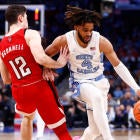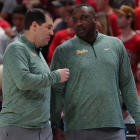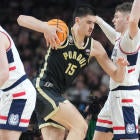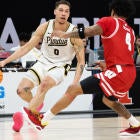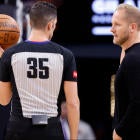Block or charge? The NCAA hopes to bring more clarity and consistency to college hoops by way of accurately distinguishing the difference between the two.
On Monday the NCAA Playing Rules Oversight Panel voted via conference call to amend the block/charge rule. The changes will be effective for the start of next season.
"Under the revised block/charge call in men’s basketball, a defensive player is not permitted to move into the path of an offensive player once he has started his upward motion with the ball to attempt a field goal or pass," according to the new rule. "If the defensive player is not in legal guarding position by this time, it is a blocking foul. Previously, a defender had to be in legal guarding position when the offensive player lifted off the floor."
Some will call this the Aaron Craft Rule; it was Craft's induced charge call that helped Ohio State get past Iowa State in Round of 32 back in March. There has been a call for clarity for block/charge the past couple of years, ever since college hoops instituted a charge circle of its own, one that is smaller than the NBA's.
The NCAA also mentions in its release that the hope will be for this rule to give the offense proper advantage; for the officials to have better delineation of plays near the rim; and to up offense in general. The dip in scoring average for men's hoops -- it was 67.5 points per game last season, the lowest in decades -- is certainly a concern.
"With these facts in mind, much of the committee’s discussion in May focused on ways to open up the game," the release said. "To that end, it will be stressed to officials that they must address the current rules throughout the game. The following types of personal fouls should be called consistently: When a defensive player keeps a hand or forearm on an opponent; When a defensive player puts two hands on an opponent; When a defensive player continually jabs by extending his arm(s) and placing a hand or forearm on the opponent; When a player uses an arm bar to impede the progress of an opponent."
The panel also made changes to monitor reviews. Men's and women's hoops will have its officials available to use the courtside monitor to confirm or deny a shot-clock violation. Obvious as it seems, this was not in the rulebook until now. There will also be monitor reviews allowed to clear up confusion over out-of-bounds determinations.
Lastly, the elbow rule was amended. Previously, if any player swung his elbow above his shoulders and made contact with an opposing player, a flagrant foul was automatic. Now that won't be the case. Officials will be able to use the monitor to determine whether elbow contact should be a flagrant 1, a flagrant 2 or no foul at all.
Right now, these are changes that are welcome. They are response by the NCAA to criticisms that have only swelled over the past few seasons. The next challenge will be the referees putting the rulebook changes to consistent and correct use.














